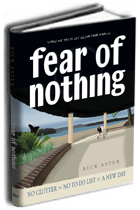I want to talk about the factorial function. It might seem an arcane piece of mathematics but it is valuable because it provides a way to measure the chaos that ordinary daily life can so easily turn into. Specifically, if you have a certain number of things to do, the factorial function tells you how many choices you have for the order you can do them in. Obviously, the question of sequence is only one aspect of the complexity that comes when you have many things, and it is not necessarily the most important question, but it is close enough, and it is a simple way to look at it mathematically. The factorial function shows you the way complexity grows when there are more things going on. The growth of complexity is faster than people intuitively expect, and the factorial function shows this to you.
In fact, the results of the factorial function are so startling that the function is written as a number with an exclamation point after it. For example, the factorial of 3 is written as “3!” which you would read as “three factorial.”
The value of 3! is 6. If you have three things to do, you can choose among six sequences to do them in. Suppose, for example, you want to feed the cat, read the mail, and send a message. You could do these three tasks in the sequence I just listed, but you have five other choices. You could send the message first, then read the mail, then feed the cat; you could feed the cat first, then send the message, then read the mail; and so on, with three other permutations (that’s the word mathematicians use for this kind of thing) to choose from.
That’s simple enough, but who has only three things to do? If you have five things to do, you have 120 choices of sequence. If you have ten things to do, that’s 3,628,800 choices — the factorial of ten is more than three million. That’s still almost manageable, though obviously you would wish to simplify it. But if you have 20 things to do, that is quite another matter. You can do them in 2,432,902,008,176,400 possible sequences — more than you can possibly imagine. The factorial of 20 is more than 2 quintillion. The factorial function goes up from there, of course, but this is the range I want to focus on. Intuition tells us there isn’t that big a difference in complexity between having 10 things and having 20 things to do, but even this simple mathematical analysis says the complexity goes up by a factor of 670 billion — it’s a change that’s big enough to care about.
I make this comparison not just to say that it is easier on your brain to have 10 things to do rather than 20, and that you might want to avoid having a whole lot of things to do if you can help it. That is perhaps obvious enough, though perhaps the analysis helps to explain how just a half-page list of things to do can be overwhelming. But there is another, more practical point to be found looking at the other side of the factorial function. If complexity grows rapidly when you add things, it declines just as rapidly when you take things away. If you have 20 things to do and you do just one of them, it shortens your to-do list by one item, by five percent, but it reduces the complexity of the situation by a factor of 20, the number of things you had to do before you did one of them. Your situation just became simpler not by five percent, but 95 percent.
Knowing this, don’t underestimate the power of a task for which you know exactly what to do and how to do it. When you go ahead, do what you need to do, and complete that one task, your situation becomes quite a bit simpler. Simpler means you have a much better chance of figuring out how the remaining things go together. Whenever you feel overwhelmed or the situation is chaotic, it makes good sense mathematically to start with the things you are most sure of. These things might seem small and unimportant, but proceed anyway, knowing that you are making progress toward a situation that you may have some hope of figuring out. There can be a temptation to start with the task that seems the most important but also the most uncertain, take a wild guess of what to do, and start moving things around in the hope that it leads somewhere. Sometimes this works but there is a risk that you just make more chaos. Take this approach with a maximum level of energy and a large number of people involved and you might start a war! This is another reason to focus on what you know for sure when you want to start making a change.
Mathematically it is not so different from a jigsaw puzzle. You change a jigsaw puzzle from chaos to order by moving one piece at a time. Every time you can put one piece in the right place, it adds measurably to the order of the picture and simplifies all the work that follows. If your life starts to look a little like a jigsaw puzzle, don’t be afraid to approach it one piece at a time.



No comments:
Post a Comment